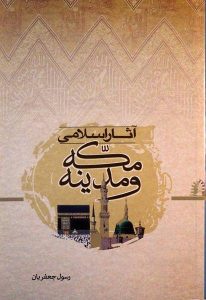Rasūl Jaʻfarīyān, Āthār-i Islāmī-yi Makkih va Madīnih [Islamic Historical Places in Mecca and Medina], Tehran: Mashʻar, 1381 Sh/ 2002; 3rd rev. ed., 1384 Sh/ 2005. 400 pp.

This book takes the reader to the backgrounds of sacred Islamic historical places, sites, and remains in Hejaz, Arabia, particularly those located in Mecca and Medina. As Muslims travel to Mecca for performing hajj and umrah and visit Medina on pilgrimage where the tomb of the Prophet Muḥammad and his praiseworthy descendants are located, they need sources that provide them with ample reliable information. Practically, the hajj tour clerics may not be able to render all this much detailed information to the hajjis they ought to supervise for correct performance of their religious mandatory rituals. In view of such practical contexts, it is necessary for the hajjis to have access to reliable sources in the field.
 This book is in the main divided into two sections: Mecca and Medina. In its Mecca section, it starts with a general introduction to the Arabian Peninsula and the Hejaz region. As for Mecca, it invites the reader to a history of Mecca from the time of the prophet Abraham who raised the walls of the Kaaba based on an initial outline which Adam had sketched. It then turns to the history of Mecca as a shrine city built and developed due to and around the Kaaba, followed by a sketch history of several rebuilding of the Kaaba. Apart from the Kaaba and the Grand Mosque (al-Masjid al-Ḥarām) to which three chapters are devoted, the book gives a catalogue of 33 historical mosques located therein, plus a mention of such regions as Minā, ʻArafāt, and Mashʻar al-Ḥarām which has recently been referred to as Muzdalifah.
This book is in the main divided into two sections: Mecca and Medina. In its Mecca section, it starts with a general introduction to the Arabian Peninsula and the Hejaz region. As for Mecca, it invites the reader to a history of Mecca from the time of the prophet Abraham who raised the walls of the Kaaba based on an initial outline which Adam had sketched. It then turns to the history of Mecca as a shrine city built and developed due to and around the Kaaba, followed by a sketch history of several rebuilding of the Kaaba. Apart from the Kaaba and the Grand Mosque (al-Masjid al-Ḥarām) to which three chapters are devoted, the book gives a catalogue of 33 historical mosques located therein, plus a mention of such regions as Minā, ʻArafāt, and Mashʻar al-Ḥarām which has recently been referred to as Muzdalifah.
As the cradle of the Islamic religion, there are several religio-historical places in Mecca. They are noteworthy for various reasons. Examples of such places are the birthplace of the Prophet Muḥammad, the home of the Prophet’s first wife, Khadījah, the Mount Ḥirā where the Prophet received the first instance of the Divine revelation.
After Mecca, the book takes the reader to Medina. Originally called Yathrib, it received its new name as Madīnah al-Nabīyy (The City of the Prophet) shortly after the historic migration of the Prophet Muḥammad from Mecca there. The new name is often shortened to Medina (in Arabic al-Madīnah al-Munawwarah or simply al-Madīnah, in Persian Madīnih).
The book invites the reader to a background and brief history of Medina and its original inhabitants before the advent of Islam. It then deals with an overall history of Medina, particularly to the periods, namely, from the 4th-6th/ 11th-13th centuries when the descendants and followers of Imam ʻAlī were in power there.

The Prophet’s shrine and its historical developments are surveyed in two separate chapters. This is followed by a listing of 38 mosques that had historical relations with the Islamic religion. For example, there is a mosque where the first Infallible Imam ʻAlī performed his eid salats. As Imam ʻAlī was cautious to follow the Prophet Muḥammad, it can be surmised that the same place might had been used by the Prophet, too.
The Baqīʻ Cemetery is another religio-historical site dealt with in detail. It is importance lies in the fact that the tombs of such outstanding Islamic personalities as the second, fourth, fifth, and sixth Infallible Imams are located there. Some of the sons of the Prophet and his companions are buried there.
As the Mount Uḥud receives its fame due to the Battle of Uḥud that took place there in 3 AH/ 624, the book contains discussions of its significance and location. It was there that the Prophet’s paternal uncle Ḥamzah was martyred and his body was torn into pieces by the Meccan polytheists.
The book makes a useful and thought-provoking guide for the pilgrims who may wish to know the sacred places they pay visit to.
